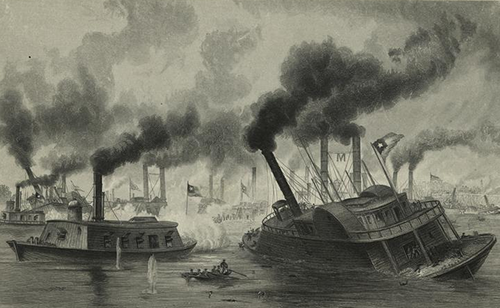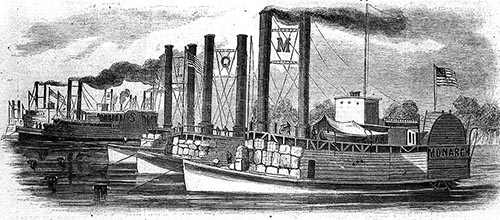
The circuitous route of the 72nd Ohio Volunteer Infantry on their way from Corinth to Memphis, Tennessee, is a matter of some speculation. Their route of march would have put them in places where Yankees were not welcome- and also other places in the upper South that enthusiastically contributed troops to the Union cause.
It must have been curious for my Great-great grandfather and his comrades to troop along the sweltering dusty roads and not know what to expect from the inhabitants of the little hamlets between Corinth and La-Grange, Grand Junction and Holly Springs, TN.
Or the looks from the young men slouched on the porches of the rude homes or hanging around the railroad stations who just weeks before might have been Rebels on the tree line.
I have a line on getting access to some documents that might clear that up at the Rutherford B. Hayes Presidential Center at Fremont, Ohio, and that is near my personal line of advance to the valleys of the Ohio River that set the course of my family’s history in the Civil War later in the summer. So I won’t worry about it just now.
The gentle late Spring of Culpeper captivated me at cocktail hour yesterday. The Russians have erected a pleasure pavilion in the wooden fenced enclosure that keeps the deer and the foxes at bay. The chicken tractor is established, with some pullets growing from yellow chicks to adolescent chickens in the blink of an eye, and the bustle of activity from five hives of happy bees.
It is an exceptional place to relax on a Memorial Day. It reminds an old Vet that there are things worth working for- and fighting for.
When I got back to the farm last night, I contemplated exactly that. It is a day for contemplation.
About this time of the year a long time ago the 72nd marched and sweated their way across Tennessee.
They missed the excitement at Memphis as they trudged toward the city in June and July of 1862. Thirteen miles a day they marched, on average. This is why they were ordered to do it: as a result of the Federal victory at Corinth, the railroads that linked Memphis with the eastern part of the Confederacy had been cut, severely reducing the strategic importance of the city.
Therefore, in early June, the Confederate cabinet in Richmond determined that Memphis and its protective forts had to be abandoned and left to the depredations of the Federals. That was to be the role of the 72nd: presence and occupation. The Confederate garrison of Bluff City was dispersed to join units elsewhere, including Vicksburg, and only a small rear guard was left to make an inconvenience to the Yankees.
The importance of the water lines of communication are a factor that the generations that travel by interstate cannot viscerally understand. There were two means of transit in those days that did not require the use of Shank’s Mare. Rail and River were the means that saved shoe-leather.
The Rebel River Defense Fleet defending Memphis would also have retreated to Vicksburg, but it could not get enough coal in Memphis to fire the boilers. Unable to flee when the Federal fleet appeared on June 6, the decision was left to a binary course of actions: fight, or scuttle the boats. They chose to fight, steaming out in the early morning to meet the advancing Union flotilla and the rams trailing behind it, with the citizens of Memphis cheering them on.
The steamboats were commercial in origin, modified by the addition of heavy timbers placed around the engineering spaces, and cotton bales stacked high to protect the firing positions. This defensive protection earned them the term “cotton-clads.” As they sortied out, the battle started with an exchange of gunfire at long range, the Federal gunboats setting up a line of battle across the river and firing their rear guns at the confederates coming up to meet them as they entered the battle, stern first.

(Line engraving published in Harper’s Weekly in 1862. Ships in the foreground are: Monarch (letter “M” between stacks), Queen of the West (with letter “Q”) and Lioness (letter “L”). In the left background are: Switzerland (with letter “S” on paddle box), Samson and Lancaster. Note cotton bales stacked on deck to protect boilers. Line engraving after a sketch by Alexander Simplot).
Maybe that is the best way to approach this battle of two largely amateur Navies. Three months before, the Department of War authorized the establishment of a flotilla of steam rams for employment on the Western Rivers. Several powerful river towboats were heavily reinforced for use as ramming ships.
Two of the four Federal rams advanced beyond the line of the gunboats and rammed or otherwise disrupted the movements of the Rebel combatants. The others, perhaps wisely, misinterpreted their orders and did not enter the battle at all. With the Federal rams and gunboats not coordinating their movements and the Confederate vessels operating independently, the battle soon was reduced to a melee.
It is agreed by all that the ram flagship USS Queen of the West collided with CSS Colonel Lovell, and then was rammed in turn by one or more of the remaining cotton-clads. The Union commander (and architect of the ram designs) was a hastily commissioned Col. Charles Ellet, who was quickly wounded by a pistol shot to his knee, thereby becoming the only casualty on the Union side.
The remainder of the battle is obscured by more than the fog of war. Several eyewitness accounts are available; unfortunately, they are mutually contradictory to a greater degree than usual. Great-Great Uncle Patrick would have approved of the story-telling. The after-action reporting generally agrees that at the end of it all but one of the cotton-clads were either destroyed or captured, and the Yankee flagship Queen of the West, was disabled.
The sole boat to escape was CSS General Earl Van Dorn, which made good for the protection of the Yazoo River north of Vicksburg. Personnel losses among the Confederates cannot be estimated reliably, and Colonel Ellet succumbed to measles contracted in the infirmary and was the only death for the Union forces.
The battle took less than two hours, and resulted in the immediate surrender of the city of Memphis to Federal authority by lunchtime.
The battle of Memphis was not quite the last battle on the Rivers, but it set the tone for the rest of the war. The ironclad CSS Arkansas would contest the Federal thrust down the Mississippi River against Vicksburg, but for now, the waters were ruled by the rag-tag Federal Fleet, augmented by the real Navy advancing upriver from New Orleans, commanded by the U.S navy’s first Rear Admiral, David Farragut. The river was now open down to Vicksburg, the key to the West. Grant would not be ready to move south until November, and until then, the South needed to be occupied.
And so the 72nd OVI marched to Memphis, arriving in late July. They would stay there until November, when Grant was ready to open the river all the way to New Orleans.
Despite the lopsided outcome, the Union Army failed to grasp its strategic significance.
The battle- one of only two entirely naval mass engagements in the war- represented the last time civilians with no prior military experience were permitted to command ships in combat. As such, it is a milestone in the development of professionalism in the United States Navy, and I applaud it. War at sea- or river- is no place for amateurs.
When the 72nd finally trudged into Memphis in late July, they were on “other duties as assigned,” and stayed in Bluff City until November of 1862. Then they were offered the opportunity to join Grant’s Central Mississippi Campaign.
Just kidding- they don’t call orders “invitations.” Off to see the elephant once more went the lads of the 72nd OVI and we will get to that story when we get to it.
Great-great Grandfather would start with operations on the Mississippi Central Railroad, and stay at it until January of 1863. A detailed appreciation for his time in Memphis will probably require a stop at Fremont, Ohio, where the 72nd was mustered in, and a vist to the Rutherford B. Hayes Presidential Library.
It is going to be a rich summer indeed.
Copyright 2015 Vic Socotra
www.vicsocotra.com
Twitter: @jayare303
